世界电力机车的发展中英文
电力机车的发展与概况
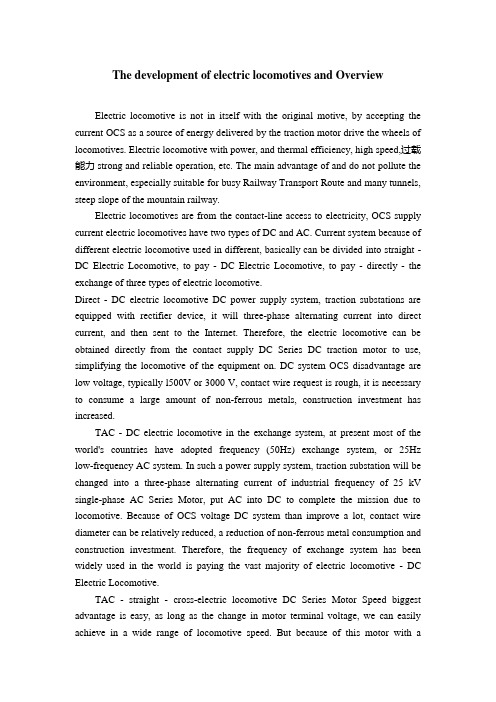
The development of electric locomotives and OverviewElectric locomotive is not in itself with the original motive, by accepting the current OCS as a source of energy delivered by the traction motor drive the wheels of locomotives. Electric locomotive with power, and thermal efficiency, high speed,过载能力strong and reliable operation, etc. The main advantage of and do not pollute the environment, especially suitable for busy Railway Transport Route and many tunnels, steep slope of the mountain railway.Electric locomotives are from the contact-line access to electricity, OCS supply current electric locomotives have two types of DC and AC. Current system because of different electric locomotive used in different, basically can be divided into straight - DC Electric Locomotive, to pay - DC Electric Locomotive, to pay - directly - the exchange of three types of electric locomotive.Direct - DC electric locomotive DC power supply system, traction substations are equipped with rectifier device, it will three-phase alternating current into direct current, and then sent to the Internet. Therefore, the electric locomotive can be obtained directly from the contact supply DC Series DC traction motor to use, simplifying the locomotive of the equipment on. DC system OCS disadvantage are low voltage, typically l500V or 3000 V, contact wire request is rough, it is necessary to consume a large amount of non-ferrous metals, construction investment has increased.TAC - DC electric locomotive in the exchange system, at present most of the world's countries have adopted frequency (50Hz) exchange system, or 25Hz low-frequency AC system. In such a power supply system, traction substation will be changed into a three-phase alternating current of industrial frequency of 25 kV single-phase AC Series Motor, put AC into DC to complete the mission due to locomotive. Because of OCS voltage DC system than improve a lot, contact wire diameter can be relatively reduced, a reduction of non-ferrous metal consumption and construction investment. Therefore, the frequency of exchange system has been widely used in the world is paying the vast majority of electric locomotive - DC Electric Locomotive.TAC - straight - cross-electric locomotive DC Series Motor Speed biggest advantage is easy, as long as the change in motor terminal voltage, we can easily achieve in a wide range of locomotive speed. But because of this motor with acommutator, so that the manufacture and repair are complex, the size is also larger. And communicate without 0 commutator traction motor (that is, three-phase asynchronous motor) in the manufacturing, performance, features, size, weight, cost, and reliability and so much more superior than the commutator motor. The reason why it should not delay the application of the electric locomotive, the main reason is speed more difficult. Terminal voltage changes should not make such a motor in the larger framework of changing the speed, but only to change the current frequency in order to achieve the objectives. Therefore, only when the electronic technology and high-power thyristor converter device is the rapid development of today can produce three-phase AC motor using advanced electric locomotive. TAC - straight - cross-electric locomotive was introduced from the contact line is still the single-phase AC electricity, which put the first single-phase AC electricity into DC rectifier, DC and then reverse into a frequency change can make a three-phase alternating current for the use of three-phase asynchronous motor . This locomotive has an excellent traction capability, promising. German-made "E120" electric locomotive of this locomotive.1866, German engineers and technicians of Siemens joint venture founded哈卢Kokoschka Electric Co., Ltd., inventions powerful generators, made out the world's first electric locomotive. The second year in Paris, on display at the Expo, shocked many people. 1879, trade and industry fair in Berlin, the car's power train the world's first public test run. Traction motor trains, the railroad tracks from the live transmission current, power 3 hp, one person may be transported 18 passengers, seven kilometers per hour. Two years later in 1881, Berlin outskirts of the laying of a small, but for the world of business with the first tram route. At the same time, Germany has successfully tested drive space contact wire power supply system, so that the power supply line electric locomotive from the ground towards the air, motorcycle voltage and power are greatly enhanced.In 1895, one in Baltimore in the United States, Ohio railway line for the first time long-distance electric locomotive. Locomotive weight 96 tons, 1080 horsepower, the use of 550V DC power supply.1901, Siemens, Kokoschka Electric Co., Ltd. manufacture electric locomotive in Berlin has created a near record of 160 kilometers per hour.At the same time, in 1880, Edison also USA tram experiment.China's first electric locomotive in 1958, was born in Hunan Zhuzhou, named"SS" for the Chinese into the electrification of the railway made a contribution.Because of electric locomotive speed, climbing ability, traction, and do not pollute the air, it developed rapidly. Mass Transit Railway in tandem with the emergence of the tram can be developedIn recent years, with electricity, the development of electronic technology, as well as the environmental awareness of the advocacy, development of electric locomotive technology has made tremendous progress. Turn the speed of electric locomotive remote control technology is an important railway sector development technologies, which restricts the development of direct electric locomotive speed and running efficiency. This paper introduces the current turn speed electric locomotive remote control technology development, analysis of the electric locomotive speed curve of the basic principles of remote control system. The latest technology to turn the speed of the electric locomotive remote control system of the heart - as the central control system to receive, to send and receive signals and alarm system for prompt assistance, the design speed of the electric locomotive remote corner of the signal transmission system, signal receiving system, single-chip control system to receive and receive alarm system. One of the topics focused on the reception of the alarm system in detail. The use of ultrasonic alarm device to receive the launch - as a locomotive arrived at the receiving device detection components curve, according to a different location to receive the encoded signal, allowing the system to issue the corresponding warning alarm signal. In this way, the smooth passage of locomotives will be able to bend, and greatly improving the operating efficiency of electric locomotive.ATC is a safe and efficient for the purpose of regulating the automatic train operation equipment spacing, through the vehicle equipment, ground equipment, stations and control centers to complete the control system to control train operation. ATC system includes three subsystems: Automatic Train Monitoring System (ATS), automatic train protection (ATP) and automatic train operation system (ATO).ATS monitoring subsystem to achieve guide the schedule of trains running on schedule, and ensure the stability of the Mass Transit Railway Operation System. Through the establishment of start point conversion approach to the train coming from the control center of the supervision order.ATP subsystem with overspeed protection, zero-speed detect and limit the functions of the door. ATP to provide speed limit information in order to maintainsafe spacing between trains, the train speed limit in the standard run. In the open car in front, ATP allowed to check a variety of conditions to open the door to check pass and then allowed to open the door.ATO subsystem can automatically adjust the speed, and can be designated parking station, the train stopped at the station smooth the correct position.ATO received from the ATS task of train operation command. Their information through the track circuit or wayside communication device is sent to train on. Processed information to the ATO, and display relevant information. ATO to obtain useful information, the combination of line speed computing are beginning to come to control the volume, and the implementation of control commands, at the same time show the relevant information. After the arrival, after the open as conditions permit, ATO to open the door. During stops, the train through the car - the train communication system and information to ground communications, and then spread to ATS. ATS train information in accordance with the running-board information to ATO.电力机车的发展与概况电力机车本身不带原动机,靠接受接触网送来的电流作为能源,由牵引电动机驱动机车的车轮。
《电力机车构造》教学课件—01电力机车总述
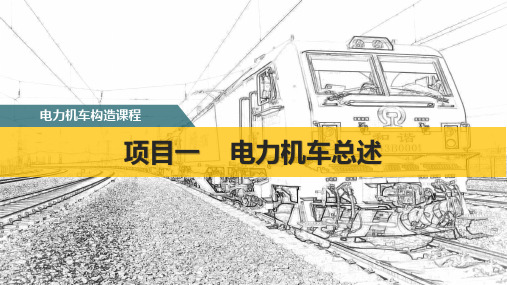
任务二 认知我国机车发展史
前进型蒸汽机车主要用于干线客/货运,1956年生产,总生产4714台, 现已基本退役。
任务二 认知我国机车发展史
建设型蒸汽机车主要用于干线货运/小运转,1957年生产,累计生产 1921台,已基本退役。
任务二 认知我国机车发展史
制造年份:1964年,设计速度:120 km/h。 东方红1型是四方机车车辆厂1959年试制,1964年批量生产的干线 客运内燃机车,机车按双机联挂设计,也可以单机使用。
电力机车构造课程
项目一
电力机车总述
任务一 任务二 任务三
世界机车的发展 我国机车的发展 电力机车的主要组成结构
任务一 任务二 任务三
世界机车的发展 我国机车的发展 电力机车的主要组成结构
任务一 认知世界机车发展史
1804年,英国人德里维斯克改进瓦特的蒸汽机,造出了世界上第一台 蒸汽机车。
蒸汽机车
任务一 认知世界机车发展史
1817-1825年,英国商人批司建成世界上第一条采用机车牵引并同时 办理客货业务的铁路。
蒸汽机车
任务一 认知世界机车发展史
1879年,德国人西门子制造出一台小型电力机车,由150 V直流发电 机供电。1890年,英国的电力机车正式用于营业;美国于1895年开始将 电力机车应用于干线运输;以后德国、日本相继研制出了实用的电力机车。
轴列式是表示机车走行部结构特点的一种方法,一般用字母表示法。
2(B0-B0)
C0-C0
THANK YOUΒιβλιοθήκη 任务二 认知我国机车发展史
8K型电力机车,是中华人民共和国铁道部于20世纪80年代通过国际 招标、按照“技贸结合”方式向欧洲五十赫兹集团订购引进的电力机车车 型,投入丰沙铁路、京包铁路使用,担当晋煤外运煤炭列车的牵引任务。
电力机车简介--中英文翻译
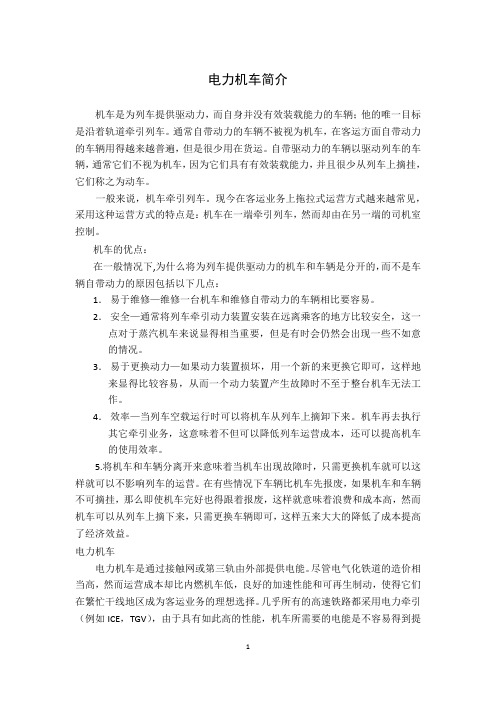
电力机车简介机车是为列车提供驱动力,而自身并没有效装载能力的车辆;他的唯一目标是沿着轨道牵引列车。
通常自带动力的车辆不被视为机车,在客运方面自带动力的车辆用得越来越普遍,但是很少用在货运。
自带驱动力的车辆以驱动列车的车辆,通常它们不视为机车,因为它们具有有效装载能力,并且很少从列车上摘挂,它们称之为动车。
一般来说,机车牵引列车。
现今在客运业务上拖拉式运营方式越来越常见,采用这种运营方式的特点是:机车在一端牵引列车,然而却由在另一端的司机室控制。
机车的优点:在一般情况下,为什么将为列车提供驱动力的机车和车辆是分开的,而不是车辆自带动力的原因包括以下几点:1.易于维修—维修一台机车和维修自带动力的车辆相比要容易。
2.安全—通常将列车牵引动力装置安装在远离乘客的地方比较安全,这一点对于蒸汽机车来说显得相当重要,但是有时会仍然会出现一些不如意的情况。
3.易于更换动力—如果动力装置损坏,用一个新的来更换它即可,这样地来显得比较容易,从而一个动力装置产生故障时不至于整台机车无法工作。
4.效率—当列车空载运行时可以将机车从列车上摘卸下来。
机车再去执行其它牵引业务,这意味着不但可以降低列车运营成本,还可以提高机车的使用效率。
5.将机车和车辆分离开来意味着当机车出现故障时,只需更换机车就可以这样就可以不影响列车的运营。
在有些情况下车辆比机车先报废,如果机车和车辆不可摘挂,那么即使机车完好也得跟着报废,这样就意味着浪费和成本高,然而机车可以从列车上摘下来,只需更换车辆即可,这样五来大大的降低了成本提高了经济效益。
电力机车电力机车是通过接触网或第三轨由外部提供电能。
尽管电气化铁道的造价相当高,然而运营成本却比内燃机车低,良好的加速性能和可再生制动,使得它们在繁忙干线地区成为客运业务的理想选择。
几乎所有的高速铁路都采用电力牵引(例如ICE,TGV),由于具有如此高的性能,机车所需要的电能是不容易得到提供。
例如应用在海底隧道货运业务的现今最大功率的机车的功率高达7MW。
世界电力机车的发展

世界电力机车的发展最早造出第一台标准轨距电力机车的是苏格兰人R·戴维森,时间是1842年。
1879年5月,德国人W·V·西门子设计制造了一台能拉乘坐18人的三辆敞开式“客车”的电力机车,这是电力机车首次成功的试验。
1881年,法国巴黎展出了第一条由架空导线供电的电车线路,这就为提高电压,采用大功率牵引电动机创造了条件:1895年,美国在巴尔的摩—俄亥俄间5.6 km长的隧道区段修建了直流电气化铁路。
1903年德国的三相交流电力机车创造了每小时210 km的高速记录。
气化铁道的发展。
建设具有真正意义的电气化铁路首先要解决如何提供高压电,改变供电制式的问题。
流),这就叫供电制式。
在电力车发展初期,主要是采用直流电力机车,另外也有一部分三相交流制和单相低频制电力机车,由于当时科学技术水平的制约,直流制电力机车供电电压不高,三相交流制接触网设备过于复杂, 单相低频制电力机车又需要单独的供电电网,因此电力机车初期发展较慢,20世纪20年代中期,接触网电压由由过去的几百V提高到了3000V,当时世界各国电气化铁道采用的都是直流制,接触网电压为1500伏~3000伏,为了克服直流电力牵引网电压低的缺点,1904年瑞士实验成功了单相工频交流电力机车,1950年法国试制了引燃管整流器式电力机车,1960年西德制成半导体整流器式电力机车,1958年美国发明晶闸管后, 晶闸管相控机车开始问世,使制造大功率机车用逆变器成为现实,工频单相交流制推动了电气化铁道的发展。
1973年~1974年爆发石油危机之后,各国对铁路电力和内燃牵引重新进行了经济评价,电力牵引更加受到青睐。
英国原先主要是发展内燃牵引,也开始重视发展电力牵引。
连已经完全内燃化的美国,铁路电气化的呼声也很高。
这时候,半导体技术和微机控制技术的突破和发展推动了新型电力机车的问世。
1979年,第一台E120型大功率采用异步电动机驱动的交—直—交电力机车在德国诞生,开创了电力机车发展的新纪元。
世界电力机车的发展.

世界电力机车的发展最早造出第一台标准轨距电力机车的是苏格兰人R·戴维森,时间是1842年。
1879年5月,德国人W·V·西门子设计制造了一台能拉乘坐18人的三辆敞开式“客车”的电力机车,这是电力机车首次成功的试验。
1881年,法国巴黎展出了第一条由架空导线供电的电车线路,这就为提高电压,采用大功率牵引电动机创造了条件:1895年,美国在巴尔的摩—俄亥俄间5.6 km长的隧道区段修建了直流电气化铁路。
1903年德国的三相交流电力机车创造了每小时210 km的高速记录。
电力机车的发展取决于电气化铁道的发展。
建设具有真正意义的电气化铁路首先要解决如何提供高压电,改变供电制式的问题。
接触网供给机车的电流制,分为直流制和交流制两种(交流制中又分单相交流、三相交流),这就叫供电制式。
在电力车发展初期,主要是采用直流电力机车,另外也有一部分三相交流制和单相低频制电力机车,由于当时科学技术水平的制约,直流制电力机车供电电压不高,三相交流制接触网设备过于复杂, 单相低频制电力机车又需要单独的供电电网,因此电力机车初期发展较慢,20世纪20年代中期,接触网电压由由过去的几百V提高到了3000V,当时世界各国电气化铁道采用的都是直流制,接触网电压为1500伏~3000伏,为了克服直流电力牵引网电压低的缺点,1904年瑞士实验成功了单相工频交流电力机车,1950年法国试制了引燃管整流器式电力机车,1960年西德制成半导体整流器式电力机车,1958年美国发明晶闸管后, 晶闸管相控机车开始问世,使制造大功率机车用逆变器成为现实,工频单相交流制推动了电气化铁道的发展。
1973年~1974年爆发石油危机之后,各国对铁路电力和内燃牵引重新进行了经济评价,电力牵引更加受到青睐。
英国原先主要是发展内燃牵引,也开始重视发展电力牵引。
连已经完全内燃化的美国,铁路电气化的呼声也很高。
这时候,半导体技术和微机控制技术的突破和发展推动了新型电力机车的问世。
电动汽车发展:过去、现在与未来外文文献翻译、中英文翻译、外文翻译
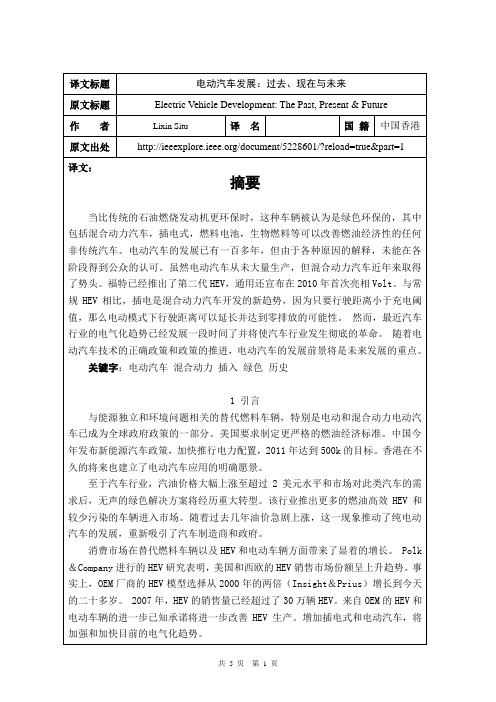
Abstract
A vehicle is consider Green when it moreenvironmentally friendly than the traditional petroleumcombustion engine, in which includes any nontraditionalvehicle like, HEV, Plug In, EV, Fuel Cell, Bio fuel etc. thatimproves fuel economy. The development of electric vehiclehas been over a hundred years but failure to gain the publicacceptance in various stages due to various reasons whichexplained. While EV was never mass produced, Hybridelectric vehicle gains the momentum in recent years. Fordhas launched its second generation of HEV and GM alsoannounced the debut of the Volt in 2010. Comparing to theregular HEV, Plug in is the new trend in hybrid autodevelopment due to extend travel range in electrical modeand a possibility of a zero emission as long as travel distanceis less than charging threshold. However, more recently, anelectrification trend in automotive industry has been evolvedand will revolutionize the industry. With the correct policyand government help and advancement of electric vehicletechnology, the prospect of Electric Vehicle will be brightand the focus point of future development.
机车的起源(翻译版)

The Growth of RailwaysChapter One:The birth of railwaysThe birth of railwaysIn factories and mines, 200 years ago, heavy trucks had to be pulled by horses, or even by people.Wooden boards were put down to make a track.铁路的诞生在工厂和矿山,200年前,重型卡车必须由马拉的,或者甚至是人。
放下使轨道被木板。
The change of tracksThe boards soon broke, so they used iron tracks, called plates. Later, they changed these for rails resting on stone or wooden blocks, called sleepers.Finally the track is formed into "工" font shape cooperating with the wheel with flange and tread, make the wheel run along the rail very well and centered automatically.轨道的变化董事会很快打破了,所以他们用铁轨道,称为板。
后来,他们改变了这些钢轨放在石头或木块,称为轨枕。
最后的轨道形成―工‖字的形状与轮缘踏面车轮的合作,使沿轨道运行的很好,中心轮自动The birth of locomotivesThen people began to make an engine which can move itself along the track to pull the trucks. The engines were called locomotives, which is Latin for “moves itself along”.For it was still in the steam engine era, people were inclined to use steam engine to drive locomotive in the first place.机车的诞生然后人们开始使发动机可沿轨道移动本身拉车。
世界电力机车的发展中英文翻译、外文翻译应用电子技术外文文献翻译

外文原文:The Development of World Electric Locomotive Electric locomotive itself with the original motive accept catenary sent by the current as a source of energy, from locomotive traction motor drive the wheels. With electric locomotive power, thermal efficiency, fast, strong and reliable operation Guozainaili major advantages, but do not pollute the environment, and particularly applicable to the busy railway transportation and tunnels, the slope of the mountain railway.Electric locomotive from the contact line access to electricity, catenary power supply current locomotives are both DC and AC. The current system different, not with the electric locomotive, can be divided into basically straight-DC electric locomotive, the TAC-DC electric locomotive, the TAC-Direct-AC electric locomotive three.Straight-DC electric locomotive using DC power supply system, traction substation equipped with rectifier devices, it will become a three-phase AC DC, and then to access the Internet. Therefore, the electric locomotive can be made online directly from the contact supply DC Series traction motor use, which simplifies the locomotive equipment. DC system's weaknesses are catenary low voltage, typically l500V or 3000 V, the contact wire request is rough, it is necessary to consume a large amount of non-ferrous metals, and increased construction investment.TAC - DC electric locomotive powered by AC system, most of the world's countries use the frequency (50Hz) exchange system, or 25 Hz low-frequency communication system. In this supply system, traction substation will be changed to three-phase alternating current frequency of 25 kV single-phase AC power industry after exposure to the Internet. But in the electric locomotive used on the string is still DC motor (which is the biggest advantage motor speed as simple as changing motor terminal voltage, it should be easy to achieve in the larger context of the locomotive speed, but such Motor due to the commutator, manufacturing and maintenance are very complex, and also greater volume), the AC into DC locomotive in the task completed. The catenary system DC voltage than to raise a lot of contact wire diameter can be relatively reduced, reducing the consumption of non-ferrous metals and construction investment did not. Therefore, the frequency communication system has been widely adopted by majority of the world's electric locomotive also pay - DC electric locomotive.TAC-Direct-exchange by exchange of non-electric locomotive traction motor commutator (that is, three-phase asynchronous motors),which is in the motor manufacturing, performance, functionality, size, weight, cost, maintenance and reliabilityand so on than the motor commutator much easier. It is the failure of the electric locomotive, is the main reason for speed rather difficult. This locomotive has excellent traction capacity promising. German-made electric locomotive E120 This is the locomotive.The working principle of electric locomotive, the current contact wire, and withstand electric locomotive into the arch after re-entering the circuit breaker after the main transformer, AC traction from the main transformer winding through silicon rectifier units, divided into two groups of six parallel to the traction motor DC supply concentrate to a traction motor torque, the mechanical energy into electric energy through the transmission gear-driven locomotive drive wheels turning.The development of electric locomotives:The first to create the first standard gauge electric locomotive is the Scots R Davidson, time is 1842. May 1879, the German Siemens W V design and manufacture of a 18 - to pull on the three open "passenger" electric locomotive, this is the first electric locomotive successful pilot. 1881, Paris, France at the first of electricity from overhead wires tram lines, which for the upgrade, using high-power traction motors to create the conditions: 1895, the United States in Baltimore - Ohio between 5.6 km long tunnel section DC electrified railway construction. 1903 Germany's three-phase AC electric locomotive created a 210 km per hour high-speed recording.Electric locomotive of development depends on the development of electrified railway. Build a real sense electrified railway is first necessary to resolve how to provide high-voltage, change standard power supply problems.Catenary locomotive current supply system, divided into DC system and the exchange of two (AC system in the single-phase AC again, three-phase AC), which called power supply standard. The frequency of the single-phase AC system to promote the development of electrified railway. 20 in the early 1970s, continental Europe and Japan in Asia is basically realized transport busy main railway electrification. 1973 ~ 1974 outbreak of the oil crisis, the national electricity and internal combustion of the railway traction re-evaluation of the economic, favored by the more electric traction. Britain is the development of the original diesel traction, but also started to attach importance to the development of electric traction. Even completely internal combustion of the United States, the voice of railway electrification also high. To the early 1980s, the world had more than 50 countries and regions to build the electrified railway, the Soviet Union's total length of electrified railway reached over 40,000 kilometers, Japan, France,West Germany have a more than 10,000 km of electrified Railway. At present, the world electrified railway has reached more than 20 million kilometres, China has also joined the more than 10,000 km of electrified railways, "senior club".Electrified railway power supply problems are solved, the development of high-power, high-speed electric locomotive on a national pursuit of the goal. At this time, the semiconductor technology and computer control technology breakthroughs and promoting the development of the birth of a new electric locomotive. 1979, the first high-power AC drive E120-electric locomotive was born in Germany, opened a new era in the development of electric locomotives.With the upgrading of existing electric locomotive and the vigorous development of high-speed railway, the development of Route electric locomotive drive from DC to AC. In the 1990s, Europe, Japan and other major motorcycle manufacturers have nearly halted DC drive electric locomotive production, AC electric locomotive has become the world's electric locomotive the mainstream of development.China's electric locomotive:Shaoshan an electric locomotive of China's earliest use of electric locomotive in 1914, is the use of the Fushun Coal Mine 1500 V DC electric locomotive. 1958 China has successfully produced the first electric locomotive, from the ignition of a rectifier to silicon rectifier, locomotives constantly improve and enhance performance, to 1976 l-made Shaoshan (SS1 type) No. 131, has been basically established. The deadline for the cessation of production in 1989, SSl electric locomotive has a total of 926 Taiwan manufacturers to become China's first electrified railway main locomotive. 1966 SS2 locomotive made in 1978 successfully developed SS3 locomotive not only improved traction performance, also of the hours of locomotive power from 200kW to a 4 kW 4800, deadline to the end of 1997, produced a total of 987, becoming the first Chinese two kinds of main electric locomotive. 1985 also has succeeded in the development of SS4 8 axis freight electric locomotive, it is China's largest electric locomotive power in a (6400 kW), has become China's main heavy-duty freight locomotive. After the successful development of a succession SS5, SS6 and SS7 electric locomotive. 1994 has succeeded in the development speed of 160 km of high-speed electric locomotive, and other 4-axis.World track for the new “pay-direct-diplomacy” electric locomotive new technology, from the late 1970s, China has been carrying out small and medium-sized railway power converter units on the ground and high-power test on the Hand-Direct-AC electric locomotive Research has also achieved initial success.Development of China's electric locomotive began in 1958. At that time, the Ministry of Railways San locomotive factory, which is now the Zhuzhou Electric Locomotive Factory in assisting the Xiangtan Electrical mining electric locomotive manufacturing plant at the same time, design and Preparation railway electric locomotive. Early 1958, the Ministry of Machinery Industry organized by the Department of the first mission to the Soviet Union study tour. At that time, the basic stereotypes of the Soviet Union is the use of 20 kV single-phase AC system Н60 frequency electric locomotive, and China decided to adopt the 25 kV single-phase AC system frequency vary, so Н60 electric locomotive on a bold technological transformation, which amounted to 78 major changes.December 28,1958, China's first electric locomotive Taiwan Railway Route Preparation successful named Y1-6.Locomotive 3410 kW continuous power, a maximum speed of 100 km / H .So far, China Route electric locomotive has been basically formed a 4,6,8 axis and 3200 kW, 6400 kW and 4800 kW power series. May 26, 1999, China's Zhuzhou Electric Locomotive Works produced the first speed of over 200 km DDJ1“bullet” electric locomotive, indicates that China has ranked as one of the electric traction in the international high-speed train service.译文:世界电力机车的发展电力机车本身的原始动机接受触网发出的电流作为能源,由机车牵引电机驱动车轮。
火车的起源发展及现状 英文物理演讲

Maglev
propulsion system 推进系统
guidance system 导向系统
Electrodynamic Suspension (EDS)
Both the guideway and the train exert a magnetic field, and the train is levitated by the repulsive and attractive force between these magnetic fields. In some configurations, the train can be levitated only by repulsive force.
The history of trains
Fixed tractor 牵引机 + track 铁轨
1817
steam locomotive 蒸汽机车
1879
electric locomotive 电力机车
electric locomotive 电力机车
An electric locomotive is a locomotive powered by electricity from overhead lines, a third rail or on-board energy storage such as a battery or fuel cell.
The history of train The principle of maglev trains
A suppose of future transporta ago, he came up with this idea
5 days ago, scientists in China accomplished
百年铁路发展史英语作文
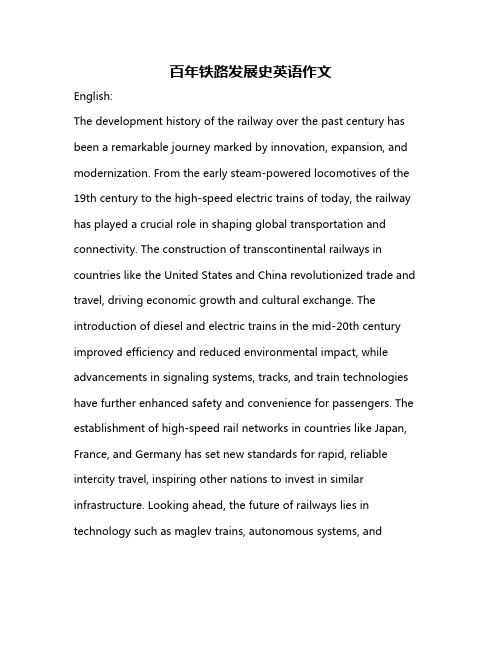
百年铁路发展史英语作文English:The development history of the railway over the past century has been a remarkable journey marked by innovation, expansion, and modernization. From the early steam-powered locomotives of the 19th century to the high-speed electric trains of today, the railway has played a crucial role in shaping global transportation and connectivity. The construction of transcontinental railways in countries like the United States and China revolutionized trade and travel, driving economic growth and cultural exchange. The introduction of diesel and electric trains in the mid-20th century improved efficiency and reduced environmental impact, while advancements in signaling systems, tracks, and train technologies have further enhanced safety and convenience for passengers. The establishment of high-speed rail networks in countries like Japan, France, and Germany has set new standards for rapid, reliable intercity travel, inspiring other nations to invest in similar infrastructure. Looking ahead, the future of railways lies in technology such as maglev trains, autonomous systems, andsustainable energy sources to continue driving progress and sustainability in transportation.中文翻译:过去一个世纪铁路的发展史是一次卓越的旅程,标志着创新、扩张和现代化。
世界电力机车的发展.

世界电力机车的发展最早造出第一台标准轨距电力机车的是苏格兰人R·戴维森,时间是1842年。
1879年5月,德国人W·V·西门子设计制造了一台能拉乘坐18人的三辆敞开式“客车”的电力机车,这是电力机车首次成功的试验。
1881年,法国巴黎展出了第一条由架空导线供电的电车线路,这就为提高电压,采用大功率牵引电动机创造了条件:1895年,美国在巴尔的摩—俄亥俄间5.6 km长的隧道区段修建了直流电气化铁路。
1903年德国的三相交流电力机车创造了每小时210 km的高速记录。
电力机车的发展取决于电气化铁道的发展。
建设具有真正意义的电气化铁路首先要解决如何提供高压电,改变供电制式的问题。
接触网供给机车的电流制,分为直流制和交流制两种(交流制中又分单相交流、三相交流),这就叫供电制式。
在电力车发展初期,主要是采用直流电力机车,另外也有一部分三相交流制和单相低频制电力机车,由于当时科学技术水平的制约,直流制电力机车供电电压不高,三相交流制接触网设备过于复杂, 单相低频制电力机车又需要单独的供电电网,因此电力机车初期发展较慢,20世纪20年代中期,接触网电压由由过去的几百V提高到了3000V,当时世界各国电气化铁道采用的都是直流制,接触网电压为1500伏~3000伏,为了克服直流电力牵引网电压低的缺点,1904年瑞士实验成功了单相工频交流电力机车,1950年法国试制了引燃管整流器式电力机车,1960年西德制成半导体整流器式电力机车,1958年美国发明晶闸管后, 晶闸管相控机车开始问世,使制造大功率机车用逆变器成为现实,工频单相交流制推动了电气化铁道的发展。
1973年~1974年爆发石油危机之后,各国对铁路电力和内燃牵引重新进行了经济评价,电力牵引更加受到青睐。
英国原先主要是发展内燃牵引,也开始重视发展电力牵引。
连已经完全内燃化的美国,铁路电气化的呼声也很高。
这时候,半导体技术和微机控制技术的突破和发展推动了新型电力机车的问世。
电力机车英文资料2 - 翻译
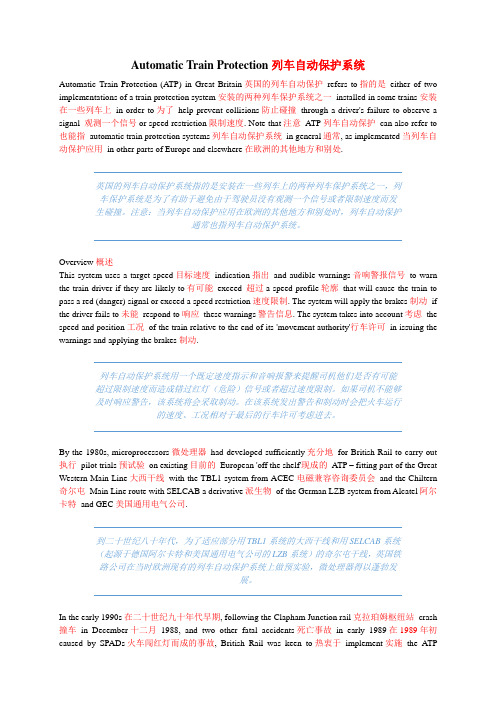
Automatic Train Protection列车自动保护系统Automatic Train Protection (ATP) in Great Britain英国的列车自动保护refers to指的是either of two implementations of a train protection system安装的两种列车保护系统之一installed in some trains安装在一些列车上in order to为了help prevent collisions防止碰撞through a driver's failure to observe a signal 观测一个信号or speed restriction限制速度. Note that注意ATP列车自动保护can also refer to 也能指automatic train protection systems列车自动保护系统in general通常, as implemented当列车自动保护应用in other parts of Europe and elsewhere在欧洲的其他地方和别处.英国的列车自动保护系统指的是安装在一些列车上的两种列车保护系统之一,列车保护系统是为了有助于避免由于驾驶员没有观测一个信号或者限制速度而发生碰撞。
注意:当列车自动保护应用在欧洲的其他地方和别处时,列车自动保护通常也指列车自动保护系统。
Overview概述This system uses a target speed目标速度indication指出and audible warnings音响警报信号to warn the train driver if they are likely to有可能exceed 超过a speed profile轮廓that will cause the train to pass a red (danger) signal or exceed a speed restriction速度限制. The system will apply the brakes制动if the driver fails to未能respond to响应these warnings警告信息. The system takes into account考虑the speed and position工况of the train relative to the end of its 'movement authority'行车许可in issuing the warnings and applying the brakes制动.列车自动保护系统用一个既定速度指示和音响报警来提醒司机他们是否有可能超过限制速度而造成错过红灯(危险)信号或者超过速度限制。
电力机车主电路的发展概述(1)

电力机车主电路的发展概述电力机车(electric locomotive)本身不带原动机、靠接受沿线接触网送来的电流作为能源、由牵引电动机驱动车轮的机车。
所需的电能,可以由多种形式(火力、水力、风力、核能等)转换而来。
电力机车具有功率大、热效率高、速度快、过载能力强和运行可靠边等主要优点,而且不污染环境,特别适用于运输繁忙的铁路干线和隧道多、坡度大的山区铁路。
发展概况【top】最早造出第一台标准轨距电力机车的是苏格兰人R·戴维森,时间是1842年,由40组蓄电池供电,但没有实用价值。
1879年5月,德国人W·VON西门子设计制造了一台能拉乘坐18人的三辆敞开式“客车”的电力机车,它由外部150V直流发电机通过第三轨供电,这是电力机车首次成功的试验。
1881年,法国在巴黎展出了第一条由架空导线供电的电车线路,这就为提高电压,采用大功率牵引电动机创造条件。
1895年,美国在巴尔的摩—俄亥俄间5. 6 km长的遂道区段修建了直流电气化铁路,在该区段上运行的干线电力机车自重97 t,采用675 V直流电,功率为1 070 kW。
1903年德国的三相交流电力机车创造了每小时210km 的高速记录。
中国最早使用电力机车在1914年,是抚顺煤矿使用的1 500 V直流电力机车。
1958年中国成功地生产出第一台电力机车,从采用引燃管整流器到硅整流器,机车性能不断改进和提高,到1976年制成韶山型(SS1型)131号时已基本定型。
截止到1989年停止生产,SS1型电力机车总共制造出厂926台,成为中国电气铁路干线的首批主型机车。
1966年SS2型机车制成。
1978年研制成功的SS3型机车,不仅改善了牵引性能,还把机车的小时功率从4 200kW提高到4 800kW,载止到1997年底,共生产了987台,成为中国第二种主型电力机车。
1985年又研制成功了SS4型8轴货运电力机车,它是国产电力机车中功率最大的一种(6 400kW),已成为中国重载货运的主型机车。
世界电力机车的发展中英文
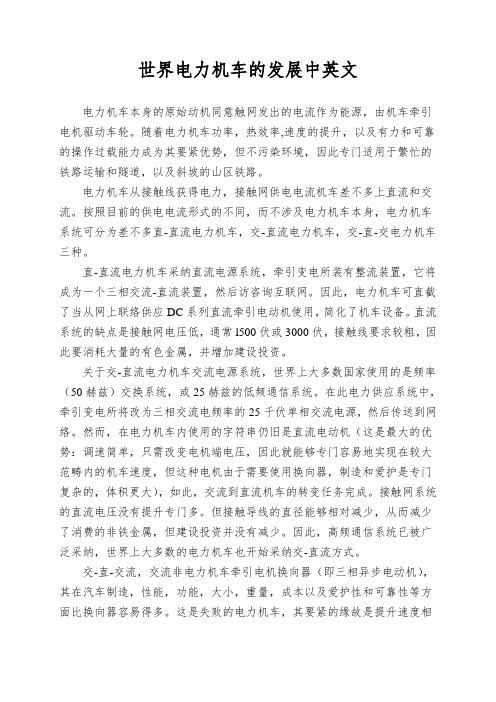
世界电力机车的发展中英文电力机车本身的原始动机同意触网发出的电流作为能源,由机车牵引电机驱动车轮。
随着电力机车功率,热效率,速度的提升,以及有力和可靠的操作过载能力成为其要紧优势,但不污染环境,因此专门适用于繁忙的铁路运输和隧道,以及斜坡的山区铁路。
电力机车从接触线获得电力,接触网供电电流机车差不多上直流和交流。
按照目前的供电电流形式的不同,而不涉及电力机车本身,电力机车系统可分为差不多直-直流电力机车,交-直流电力机车,交-直-交电力机车三种。
直-直流电力机车采纳直流电源系统,牵引变电所装有整流装置,它将成为一个三相交流-直流装置,然后访咨询互联网。
因此,电力机车可直截了当从网上联络供应DC系列直流牵引电动机使用,简化了机车设备。
直流系统的缺点是接触网电压低,通常l500伏或3000伏,接触线要求较粗,因此要消耗大量的有色金属,并增加建设投资。
关于交-直流电力机车交流电源系统,世界上大多数国家使用的是频率(50赫兹)交换系统,或25赫兹的低频通信系统。
在此电力供应系统中,牵引变电所将改为三相交流电频率的25千伏单相交流电源,然后传送到网络。
然而,在电力机车内使用的字符串仍旧是直流电动机(这是最大的优势:调速简单,只需改变电机端电压,因此就能够专门容易地实现在较大范畴内的机车速度,但这种电机由于需要使用换向器,制造和爱护是专门复杂的,体积更大),如此,交流到直流机车的转变任务完成。
接触网系统的直流电压没有提升专门多。
但接触导线的直径能够相对减少,从而减少了消费的非铁金属,但建设投资并没有减少。
因此,高频通信系统已被广泛采纳,世界上大多数的电力机车也开始采纳交-直流方式。
交-直-交流,交流非电力机车牵引电机换向器(即三相异步电动机),其在汽车制造,性能,功能,大小,重量,成本以及爱护性和可靠性等方面比换向器容易得多。
这是失败的电力机车,其要紧的缘故是提升速度相当困难。
但这种机车具有优良的牵引能力。
论文外文文献、
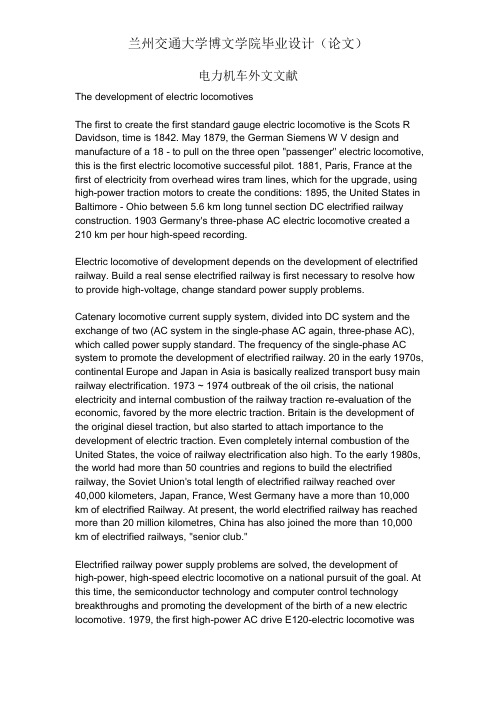
电力机车外文文献The development of electric locomotivesThe first to create the first standard gauge electric locomotive is the Scots R Davidson, time is 1842. May 1879, the German Siemens W V design and manufacture of a 18 - to pull on the three open "passenger" electric locomotive, this is the first electric locomotive successful pilot. 1881, Paris, France at the first of electricity from overhead wires tram lines, which for the upgrade, using high-power traction motors to create the conditions: 1895, the United States in Baltimore - Ohio between 5.6 km long tunnel section DC electrified railway construction. 1903 Germany's three-phase AC electric locomotive created a 210 km per hour high-speed recording.Electric locomotive of development depends on the development of electrified railway. Build a real sense electrified railway is first necessary to resolve how to provide high-voltage, change standard power supply problems.Catenary locomotive current supply system, divided into DC system and the exchange of two (AC system in the single-phase AC again, three-phase AC), which called power supply standard. The frequency of the single-phase AC system to promote the development of electrified railway. 20 in the early 1970s, continental Europe and Japan in Asia is basically realized transport busy main railway electrification. 1973 ~ 1974 outbreak of the oil crisis, the national electricity and internal combustion of the railway traction re-evaluation of the economic, favored by the more electric traction. Britain is the development of the original diesel traction, but also started to attach importance to the development of electric traction. Even completely internal combustion of the United States, the voice of railway electrification also high. To the early 1980s, the world had more than 50 countries and regions to build the electrified railway, the Soviet Union's total length of electrified railway reached over40,000 kilometers, Japan, France, West Germany have a more than 10,000 km of electrified Railway. At present, the world electrified railway has reached more than 20 million kilometres, China has also joined the more than 10,000 km of electrified railways, "senior club."Electrified railway power supply problems are solved, the development ofhigh-power, high-speed electric locomotive on a national pursuit of the goal. At this time, the semiconductor technology and computer control technology breakthroughs and promoting the development of the birth of a new electric locomotive. 1979, the first high-power AC drive E120-electric locomotive wasborn in Germany, opened a new era in the development of electric locomotives.With the upgrading of existing electric locomotive and the vigorous development of high-speed railway, the development of Route electric locomotive drive from DC to AC. In the 1990s, Europe, Japan and other major motorcycle manufacturers have nearly halted DC drive electric locomotive production, AC electric locomotive has become the world's electric locomotive the mainstream of development.对电力机车的发展第一个发明第一个标准计电力机车是苏格兰R·戴维森,时间是1842年。
电力机车简介外文文献翻译、中英文翻译、外文翻译
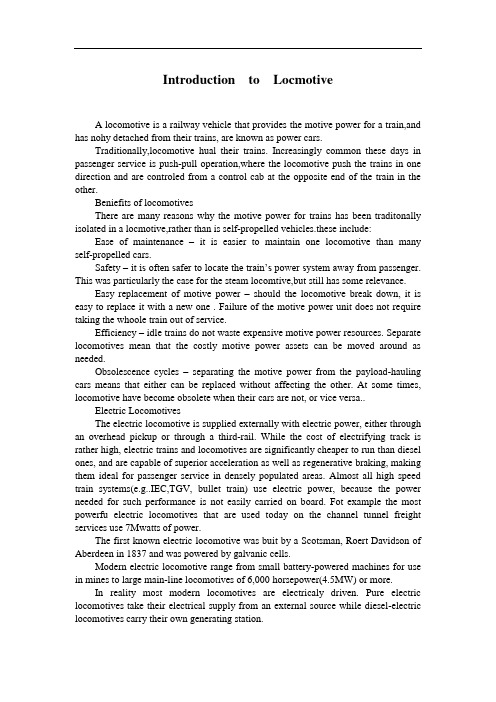
Introduction to LocmotiveA locomotive is a railway vehicle that provides the motive power for a train,and has nohy detached from their trains, are known as power cars.Traditionally,locomotive hual their trains. Increasingly common these days in passenger service is push-pull operation,where the locomotive push the trains in one direction and are controled from a control cab at the opposite end of the train in the other.Beniefits of locomotivesThere are many reasons why the motive power for trains has been traditonally isolated in a locmotive,rather than is self-propelled vehicles.these include: Ease of maintenance –it is easier to maintain one locomotive than many self-propelled cars.Safety –it is often safer to locate the train’s power system away from passenger. This was particularly the case for the steam locomtive,but still has some relevance.Easy replacement of motive power –should the locomotive break down, it is easy to replace it with a new one . Failure of the motive power unit does not require taking the whoole train out of service.Efficiency – idle trains do not waste expensive motive power resources. Separate locomotives mean that the costly motive power assets can be moved around as needed.Obsolescence cycles –separating the motive power from the payload-hauling cars means that either can be replaced without affecting the other. At some times, locomotive have become obsolete when their cars are not, or vice versa..Electric LocomotivesThe electric locomotive is supplied externally with electric power, either through an overhead pickup or through a third-rail. While the cost of electrifying track is rather high, electric trains and locomotives are significantly cheaper to run than diesel ones, and are capable of superior acceleration as well as regenerative braking, making them ideal for passenger service in densely populated areas. Almost all high speed train systems(e.g..IEC,TGV, bullet train) use electric power, because the power needed for such performance is not easily carried on board. Fot example the most powerfu electric locomotives that are used today on the channel tunnel freight services use 7Mwatts of power.The first known electric locomotive was buit by a Scotsman, Roert Davidson of Aberdeen in 1837 and was powered by galvanic cells.Modern electric locomotive range from small battery-powered machines for use in mines to large main-line locomotives of 6,000 horsepower(4.5MW) or more.In reality most modern locomotives are electricaly driven. Pure electric locomotives take their electrical supply from an external source while diesel-electric locomotives carry their own generating station.Main line electric locomotives first appeared at the beginning of the 20th century.The reason for their introduction was the problem of smoke, especially in tunnlels caused by steam locomotives. In the UK this was the London underground system while in the USA, it was under river tunnles and needs to eliminate smoke in built up areas.Early electric locomotives all relied on external power sourcing. Once up and running they tend to be reliable and efficint, but the supply infrastructure is a large capital expense that does require ongoing maintenance. For this reason only heavily used lines could justify electrification. For suburban lines the reduction in pollution from steam locomotives was a benefit all were aware oflThe world speed record for a wheeled train was set in 1990 ba a French TGV which reached a speed of 515.3km/h (320mph).While recently designed electrififed railway systems invariably operate on alternating current, many existing direct current sytems are still in use –e.g. in South Africa,Spain,and the United Kingdom(750v and 1500v); Netherlands(1500v); Belgiu, Italy, Poland (3000 v), and the cites of Mumbia and Chicagio (which will be switched to AC by 2025).Early locomotives came in a variety of forms. Generally they were designed to run off the supplied current. so locomotives with a direct current (DC) supply had DC motors while a alterntating current(AC) supplied locomotives with AC motors. AC can be either single or three phase. While the former requies two wire supply, one overhead the other being the track, three phase require three supply wire.Three phase locomotives therefore had two overhead supplies,the track being the third.DC supplies were either overhead or by means of a track level supply, commonly called the third rail.AC traction motors tended to be smaller than DC motors. This often meant electric locomotives with steam engine type cranks. DC motors could be smaller and set up to drive the ually through a gear ,but in some early examples by being part of the axle. Even so, some notable DC electric locomotives had large DC motors driving large driving wheels.One possibility with electric locomotives is that the motor can be used as a generator during braking, feeding electricity back into the supply system; this is called regenerative barking. This is not a new idea, it was one reason for the adoption by some railways of 3 phase AC suppies. Especially in mountainous aresa where the locomotive going down would generate much of the suppy for a locomotive going up. The Swiss railway uses the system; three modern locomotives heading downwards generate enough power to power a single locomotive in its upward journey.Today all eclctric locomotives tend to have drive motors close to the axles, although some still have the motor in the body driving the wheels through internal drive shafts.Modern solid state electrical control systems means the motor does not need to match the supply. This meams multi-voltage cross border locomotives are now quitecommon. Drive motors are generally DC, but there are 3 phase motors on some locomotives.A small number of electric locomotives can also operate off batery power to enable short journeys or shuting to occur on non-electrified lines or yards. Pure battery locomotives also found usage in mines and other underground workings where diesel fumes or smoke are not safe aand where external electricity supplies could not be used. Battery locomotives are also used on many underground railways for maintenance operations as they are required to operate in areas where the electricity supply has been temmporarily disconnected..Parts of Electric LocomotiveAwynchronoux MotorModern traction motor type using three phase AC electrical supply and now the favoured deisgn for modern train traction systems . Can be used on DC and AC electrified. railways with suitable control electronics and on diesel-electric locomtives.Axle BrushThe means by which the power supply ciruit is completed with the substation once power has been drawn on the locomotive. Current collected from the overhead line or third rail is returned via the axle brush and one of the running rails.BatteryAll trains are provided with a battery to provide start up current for supplying essential circuitts, such as emergency lighting ,when the line supply fails. The battery is usually connected across the DC control supply circuit.Circuit BreakerAn electric train is almost always provied with some sort of circuit breaker to isolate the power supply when there is a fault, or for maintenance. On AC systems they are usually on the roof near the pantograph. There are two types-the air blast circuit breaker and the vacuum circuit breaker or VCB. The air or vacuum part is used to extinguish the arc which occurs as the two tips of the circuit breaker are opened. The VCB is popular in the UK and the air blast circuit breaker is more often seen on the continent of Europe.ConverterGeneric term for any solid state electronic system for converting alternating current to direct current or vice versa. Where an AC supply has to be converted to DC it is called a rectifier and where DC is converted to AC it is called an inverter. The word originated in the US but is now common elsewhere.Cooling FansTo keep the thyristors and other electronic power systems cool, the interior of a modern locomotive is equipped with an air management system, electronically controlled to keep all systems operating at the correct temperature. The fans are powered by an auxiliary inverter producing 3-phase AC at about 400 volts.DC linkUsed on modern electronic power systems between the single phase rectifier and the 3-phase inverter. It is easier to convert the single phase AC from the overheak line to the 3-phase required for the motors by rectifying it to DC and then inverting the DC to 3-phase AC.InverterElectronic power device mounted on trains to provide alternating current from direct current. Popular nowadays for DC railways to allow three phase drive or for auxiliary supplies which need an AC supply.Line BreakerElectro-mechanical switch in a traction motor power circuit used to active or disable the circuit the circuit. It is nomally closed to start the train and remains closed all the time power is required. It is opened by a command from the driving controller,no-volts detected, overload detected and (were required) wheel spin or slide detected. It is linked to the overload and no-volt control circuits so that it actually functions as a protective circuit breaker.Master ControllerDriver’s power control device located in the cab. The driver moves the handle of the master controller to apply or reduce power to the locomotive or train.Motor BlowersTraction motors on electric locomotives get very hot and to keep their temperature at a reasonable level for long periods of hard word, they are usually fitted with electric fans called motor blowers. On a modern locomotive,they are powered by an auxiliary 3-phase AC supply of around 400 volts supplied by an auxiliary inverter.RectiferA converter consisting of thyristors and diodes which is used to convert AC to DC. A modern locomotive will usually have at least two, one for the power circuits and one or more for the auxiliary circuits.Synchronous MotorTraction motor where the field coils are mounted on the drive shaft and the armature coils in the housing, the inverse of normal practice.Favoured by the French and used on the high speed TGV Atlantique trains, this is a single-phase machine controlled by simple inverter. Now superseded by the asynchronous motor.TransformerA set of windings with a magnetic core used to step down or step up a voltage from one level to another.The voltage differences are determined by the proportion of windings in the input side compared with the proportion on the output side. An essential requirement for locomotives and trains using AC power, where the line voltage has to be stepped down before use on the train.Equipment LayoutVentilation SystemEquipment layout and ventilation systems 设备布置和通风系统设计Equipment layout and design of the ventilation system电力机车简介机车是为列车提供驱动力,而自身并没有效装载能力的车辆;他的唯一目标是沿着轨道牵引列车。
电力机车绪论1

电力机车机械部分的组成、功用、意义 (三)车体与转向架的连接装置 设于车体和转向架之间。连接、传力、缓冲及活 动关节。又是二系悬挂。 (四)牵引缓冲装置 包括:车钩缓冲器,设于机车低架两端 连接、缓冲、传力。
轴列式:用数字或字母表示机车走行结构特 点。
数字法:数字表示每台转向架的轴数,有注脚“0” 每个动轴单独驱动,否则表示动轴成组驱动。
1803年英国人R.Trevithick发明了世界上第一台 蒸汽机车。1829年乔治和R.Stephenson父子设计 并制造出多烟管蒸汽机车“火箭号(Rocket)”
1825年9月25日世界第一列蒸汽旅客列车在英国 Stockton-Darlington(42km)的线路上开通。 1935年德国纽伦堡开行其第一列的蒸汽旅客列车
电力机车的组成
电气部分:牵引变压器、牵引电动机、硅整 流装置等。(能量转换、控制) 机械部分:车体、转向架、车体支承装置、 牵 引缓冲装置。(本学期重点内容) 空气管路系统:风源系统、制动气路、控制 气路、辅助气路。
电力机车机械部分的组成、功用、意义 车体:机车上部车厢部分
司机室:乘务员操纵机车的工作场所, 设在车体两端,机车可双向行使。 机器间:用于布置车内主要电器设备, 由两个辅助室、两个高压室、一个变压器室 组成。
中国铁路历史:1875年(光绪元年)上海到吴 淞口轻便窄轨铁路;1880年唐山~胥各庄矿 区轻便铁路,马牵引;1881年改用简易蒸汽 机车牵引。
唐胥铁路用 蒸汽机车现代蒸汽车内燃机车电力机车概念
电力机车是从接触网上获取电能的, 接触网供给电力机车的电流有直流和交 流两种,再加上车上牵引电机的不同, 电力机车基本上可以分为直-直流电力机 车、交-直流电力机车、交-直-交流电力 机车三类。
电气化铁路中英文对照

世界各国电气化铁路发展概况十九世纪二十年代,1825年世界上第一条铁路在英国建成。
而后,1879年5月31日在德国柏林举办的世界贸易博览会上,由西门子和哈尔斯克公司展出了世界上第一条电气化铁路,迄今已有120多年的历史。
目前,世界上共有68个国家和地区修建了电气化铁路,总里程已达258566km,约占世界铁路总营业里程(约120万km)的22。
5%,承担世界铁路总运量的50%以上。
也就是说仅占世界铁路总营业里程不到四分之一的电气化铁路承担着世界铁路总运量的一半以上的运输任务。
最初,电气化铁路都修建在城市近郊线路和一些工矿线路上。
后来,随着工业的发展,才逐渐发展到城市之间和运输繁忙的干线铁路上来。
20 世纪60~70年代是世界电气化铁路发展最快的时期,平均每年修建达5000多公里。
在此期间,工业发达的西欧、日本、前苏联,以及东欧等国家,运输繁忙的主要铁路干线实现了电气化,而且基本上已经成网。
1964年10月日本建成世界上第一条高速电气化铁路--东海道新干线,以210km的时速令世人瞩目。
1961年8月15日我国第一条电气化铁路在新建的宝成线宝鸡~凤州段正式通车.之后,由于种种原因,电气化铁路建设处于停顿状态,直到60年代末,宝成线凤州~成都段才重新上马,于1975年7月1日全线通车。
与此同时,阳安线于1973年9月开工,1977年6月25日建成通车。
由此可见,在世界电气化铁路发展最快的时期,我国的电气化铁路建设是非常缓慢的,整整20年的时间,只修建了宝成线和阳安线两条电气化铁路,合计仅1033km,平均每年还不到52km.另外襄渝线刚刚开始动工,进度缓慢。
20世纪80年代以后,世界上又出现了一个电气化铁路建设高潮。
一些发展中国家,如中国、印度、土耳其、巴西等国的电气化铁路建设也开始快了起来。
例如:印度1990~1991年两年就建成电气化铁路1557km,平均每年建成近800km;从1981~2000年,我国在“六五”、“七五”、“八五”和“九五"四个五年计划期间的二十年内,分别建成2507。
- 1、下载文档前请自行甄别文档内容的完整性,平台不提供额外的编辑、内容补充、找答案等附加服务。
- 2、"仅部分预览"的文档,不可在线预览部分如存在完整性等问题,可反馈申请退款(可完整预览的文档不适用该条件!)。
- 3、如文档侵犯您的权益,请联系客服反馈,我们会尽快为您处理(人工客服工作时间:9:00-18:30)。
冯博:基于MA TLAB的HXD3电力机车主电路的建模和仿真附录B中文翻译世界电力机车的发展电力机车本身的原始动机接受触网发出的电流作为能源,由机车牵引电机驱动车轮。
随着电力机车功率,热效率,速度的提高,以及有力和可靠的操作过载能力成为其主要优势,但不污染环境,所以特别适用于繁忙的铁路运输和隧道,以及斜坡的山区铁路。
电力机车从接触线获得电力,接触网供电电流机车都是直流和交流。
根据目前的供电电流形式的不同,而不涉及电力机车本身,电力机车系统可分为基本直-直流电力机车,交-直流电力机车,交-直-交电力机车三种。
直-直流电力机车采用直流电源系统,牵引变电所装有整流装置,它将成为一个三相交流-直流装置,然后访问互联网。
因此,电力机车可直接从网上联络供应DC系列直流牵引电动机使用,简化了机车设备。
直流系统的缺点是接触网电压低,通常l500伏或3000伏,接触线要求较粗,因此要消耗大量的有色金属,并增加建设投资。
对于交-直流电力机车交流电源系统,世界上大多数国家使用的是频率(50赫兹)交换系统,或25赫兹的低频通信系统。
在此电力供应系统中,牵引变电所将改为三相交流电频率的25千伏单相交流电源,然后传送到网络。
但是,在电力机车上使用的字符串仍然是直流电动机(这是最大的优势:调速简单,只需改变电机端电压,因此就可以很容易地实现在较大范围内的机车速度,但这种电机由于需要使用换向器,制造和维护是非常复杂的,体积更大),这样,交流到直流机车的转变任务完成。
接触网系统的直流电压没有提高很多。
但接触导线的直径可以相对减少,从而减少了消费的非铁金属,但建设投资并没有减少。
因此,高频通信系统已被广泛采用,世界上大多数的电力机车也开始采用交-直流方式。
交-直-交流,交流非电力机车牵引电机换向器(即三相异步电动机),其在汽车制造,性能,功能,大小,重量,成本以及维护性和可靠性等方面比换向器容易得多。
这是失败的电力机车,其主要的原因是提高速度相当困难。
但这种机车具有优良的牵引能力。
因此还是大有希望。
德国制造的电力机车E120就是这种机车。
电力机车的工作原理:目前的接触线和电力机车经过拱形后后重新进入断路器后,主变压器,交流牵引从主变压器绕组通过硅整流单位,分成两组,六个平行对牵引电机直流电源集中到牵引电动机的扭矩,机械能变成电能通过传动齿轮驱动的机车驱动车轮转动。
华东交通大学毕业设计电力机车的发展:首先制造了第一个标准衡量电力机车的是苏格兰人戴维森,时间是1842年。
1879年5月,西弗吉尼亚州的德国西门子公司设计和制造的18—撤出三个公开“乘客”电力机车,这是第一个电力机车成功的试点。
1881年,法国巴黎架设第一电力架空线-电车线,它的升级,为使用高功率牵引电机创造条件:1895年,美国巴尔的摩-俄亥俄州之间的5.6公里长的隧道部分直流电气化铁路建设成功。
1903年德国的三相交流电力机车创造了每小时210公里的高速记录。
电力机车的发展取决于发展的电气化铁路。
建立一个真正意义上的电气化铁路首先要解决如何提供高电压,改变标准的电力供应问题。
目前机车接触网供电系统,分为直流系统和交流两个(交流系统包括单相交流,三相交流),其中要求电源标准。
单相交流系统促进发展电气化铁路。
20世纪70年代初,欧洲大陆和日本在亚洲是基本实现了交通繁忙。
交通繁忙主要是铁路电气化。
1973年至1974年爆发的石油危机,重新评估的经济指标是国家电力和内燃牵引的铁路,更青睐电力牵引。
英国是发展的原始柴油牵引的国家,但也开始重视发展电力牵引。
甚至完全靠内燃机的美国,铁路电气化的呼声也很高。
到80年代初,世界上有50多个国家和地区建设电气化铁路,苏联的总长度达到了四万公里。
日本,法国,西德有超过10000公里的电气化铁路。
目前,世界电气化铁路已达到20多万公里。
我国也加入了超过10,000公里的电气化铁路“高级俱乐部”。
电气化铁路供电问题得到解决之后,发展高功率,高速的电力机车成为很多国家追求的目标。
在这个时候,半导体技术和计算机控制技术的突破,促进发展催生了新的电力机车。
1979年,第一高功率交流传动E120电力机车诞生于德国,为发展电力机车创了一个新时代。
与提高现有电力机车速度和大力发展高速铁路相适应,发展干线电力机车开始从直流传动到交流的转变。
到20世纪90年代,欧洲,日本和其他主要摩托车制造商几乎停止直流传动电力机车的生产,交流电力机车已成为世界上电力机车发展的主流。
中国的电力机车:韶山I型电力机车是我国最早使用的电力机车。
始于1914年,是应用于抚顺煤矿的1500 V直流电力机车。
1958年我国成功地生产了第一列电力机车,从点火到一个整流器-可控硅整流器,机车不断改进,业绩提高不断,到1976年, L型作出韶山(韶山Ⅰ型)第131号,已基本确立。
直到1989年停止生产的最后期限,SSL电力机车共有926家台湾制造商,成为我国第一个电气化铁路主要火车头。
1966列SS2机车于1978年研制成功。
不仅使SS3型机车牵引性能改进,而且每小时的机车功率从200kW至4千瓦,截止到1997年底,共生产了987列,成为第一次中国两种主要的电力机车。
1985年还成功地发展冯博:基于MA TLAB的HXD3电力机车主电路的建模和仿真了SS4型8轴货运电力机车,这是我国最大功率的电力机车(6400千瓦),已成为我国主要的重型货运机车。
然后又成功继承发展SS5 , SS6和SS7型电力机车。
1994年已成功地发展了速度达160公里的高速电力机车以及其他4轴电力机车。
伴随着世界潮流,诞生了新的“直-交”电力机车技术。
从20世纪70年代末,我国一直在进行中小型铁路功率变换器的研究。
在地面上的高功率测试也在进行中,直-交流电力机车研究也已取得初步成效。
发展我国电力机车始于1958年。
在那个时候,铁道部第三机车厂,即现在的株洲电力机车厂在协助湘潭电机采矿电力机车制造工厂的同时,设计和编制铁路电力机车。
1958年年初,该部机械工业部组织第一次访问苏联考察。
在那个时候,基本定型的观念是:由于苏联使用20千伏单相交流系统Н60频率电力机车,因此中方决定采取25千伏单相交流系统,并且频率各不相同。
所以Н60电力机车是一个大胆的技术改造,这相当于78个重大变化。
1958年12月28日,我国第一台电力机车研制成功的铁路干线,命名“Y1-6”,机车持续功率3410千瓦,最高速度100公里/小时。
到目前为止,我国干线电力机车已基本形成了4,6,8轴和3200千瓦,6400千瓦和4800千瓦幂级数。
1999年5月26日,我国的株洲电力机车厂生产了第一个速度超过200公里DDJ1子弹头型电力机车,标志着我国电力牵引已跻身于国际高速列车服务行列。
冯博:基于MA TLAB的HXD3电力机车主电路的建模和仿真附录A外文文献The Development of World Electric Locomotive Electric locomotive itself with the original motive accept catenary sent by the current as a source of energy, from locomotive traction motor drive the wheels. With electric locomotive power, thermal efficiency, fast, strong and reliable operation Guozainaili major advantages, but do not pollute the environment, and particularly applicable to the busy railway transportation and tunnels, the slope of the mountain railway.Electric locomotive from the contact line access to electricity, catenary power supply current locomotives are both DC and AC. The current system different, not with the electric locomotive, can be divided into basically straight-DC electric locomotive, the TAC-DC electric locomotive, the TAC-Direct-AC electric locomotive three.Straight-DC electric locomotive using DC power supply system, traction substation equipped with rectifier devices, it will become a three-phase AC DC, and then to access the Internet. Therefore, the electric locomotive can be made online directly from the contact supply DC Series traction motor use, which simplifies the locomotive equipment. DC system's weaknesses are catenary low voltage, typically l500V or 3000 V, the contact wire request is rough, it is necessary to consume a large amount of non-ferrous metals, and increased construction investment.TAC - DC electric locomotive powered by AC system, most of the world's countries use the frequency (50Hz) exchange system, or 25 Hz low-frequency communication system. In this supply system, traction substation will be changed to three-phase alternating current frequency of 25 kV single-phase AC power industry after exposure to the Internet. But in the electric locomotive used on the string is still DC motor (which is the biggest advantage motor speed as simple as changing motor terminal voltage, it should be easy to achieve in the larger context of the locomotive speed, but such Motor due to the commutator, manufacturing and maintenance are very complex, and also greater volume), the AC into DC locomotive in the task completed. The catenary system DC voltage than to raise a lot of contact wire diameter can be relatively reduced, reducing the consumption of non-ferrous metals and construction investment did not. Therefore, the frequency communication system has been widely adopted by majority of the world's electric locomotive also pay - DC electric locomotive.TAC-Direct-exchange by exchange of non-electric locomotive traction motor华东交通大学毕业设计commutator (that is, three-phase asynchronous motors),which is in the motor manufacturing, performance, functionality, size, weight, cost, maintenance and reliability and so on than the motor commutator much easier. It is the failure of the electric locomotive, is the main reason for speed rather difficult. This locomotive has excellent traction capacity promising. German-made electric locomotive E120 This is the locomotive.The working principle of electric locomotive, the current contact wire, and withstand electric locomotive into the arch after re-entering the circuit breaker after the main transformer, AC traction from the main transformer winding through silicon rectifier units, divided into two groups of six parallel to the traction motor DC supply concentrate to a traction motor torque, the mechanical energy into electric energy through the transmission gear-driven locomotive drive wheels turning.The development of electric locomotives:The first to create the first standard gauge electric locomotive is the Scots R Davidson, time is 1842. May 1879, the German Siemens W V design and manufacture of a 18 - to pull on the three open "passenger" electric locomotive, this is the first electric locomotive successful pilot. 1881, Paris, France at the first of electricity from overhead wires tram lines, which for the upgrade, using high-power traction motors to create the conditions: 1895, the United States in Baltimore - Ohio between 5.6 km long tunnel section DC electrified railway construction. 1903 Germany's three-phase AC electric locomotive created a 210 km per hour high-speed recording.Electric locomotive of development depends on the development of electrified railway. Build a real sense electrified railway is first necessary to resolve how to provide high-voltage, change standard power supply problems.Catenary locomotive current supply system, divided into DC system and the exchange of two (AC system in the single-phase AC again, three-phase AC), which called power supply standard. The frequency of the single-phase AC system to promote the development of electrified railway. 20 in the early 1970s, continental Europe and Japan in Asia is basically realized transport busy main railway electrification. 1973 ~ 1974 outbreak of the oil crisis, the national electricity and internal combustion of the railway traction re-evaluation of the economic, favored by the more electric traction. Britain is the development of the original diesel traction, but also started to attach importance to the development of electric traction. Even completely internal combustion of the United States, the voice of railway electrification also high. To the early 1980s, the冯博:基于MA TLAB的HXD3电力机车主电路的建模和仿真world had more than 50 countries and regions to build the electrified railway, the Soviet Union's total length of electrified railway reached over 40,000 kilometers, Japan, France, West Germany have a more than 10,000 km of electrified Railway. At present, the world electrified railway has reached more than 20 million kilometres, China has also joined the more than 10,000 km of electrified railways, "senior club".Electrified railway power supply problems are solved, the development of high-power, high-speed electric locomotive on a national pursuit of the goal. At this time, the semiconductor technology and computer control technology breakthroughs and promoting the development of the birth of a new electric locomotive. 1979, the first high-power AC drive E120-electric locomotive was born in Germany, opened a new era in the development of electric locomotives.With the upgrading of existing electric locomotive and the vigorous development of high-speed railway, the development of Route electric locomotive drive from DC to AC. In the 1990s, Europe, Japan and other major motorcycle manufacturers have nearly halted DC drive electric locomotive production, AC electric locomotive has become the world's electric locomotive the mainstream of development.China's electric locomotive:Shaoshan an electric locomotive of China's earliest use of electric locomotive in 1914, is the use of the Fushun Coal Mine 1500 V DC electric locomotive. 1958 China has successfully produced the first electric locomotive, from the ignition of a rectifier to silicon rectifier, locomotives constantly improve and enhance performance, to 1976 l-made Shaoshan (SS1 type) No. 131, has been basically established. The deadline for the cessation of production in 1989, SSl electric locomotive has a total of 926 Taiwan manufacturers to become China's first electrified railway main locomotive. 1966 SS2 locomotive made in 1978 successfully developed SS3 locomotive not only improved traction performance, also of the hours of locomotive power from 200kW to a 4 kW 4800, deadline to the end of 1997, produced a total of 987, becoming the first Chinese two kinds of main electric locomotive. 1985 also has succeeded in the development of SS4 8 axis freight electric locomotive, it is China's largest electric locomotive power in a (6400 kW), has become China's main heavy-duty freight locomotive. After the successful development of a succession SS5, SS6 and SS7 electric locomotive. 1994 has succeeded in the development speed of 160 km of high-speed electric locomotive, and other 4-axis.World track for the new “pay-direct-diplomacy” electric locomotive new technology, from the late 1970s, China has been carrying out small and medium-sized railway power华东交通大学毕业设计converter units on the ground and high-power test on the Hand-Direct-AC electric locomotive Research has also achieved initial success.Development of China's electric locomotive began in 1958. At that time, the Ministry of Railways San locomotive factory, which is now the Zhuzhou Electric Locomotive Factory in assisting the Xiangtan Electrical mining electric locomotive manufacturing plant at the same time, design and Preparation railway electric locomotive. Early 1958, the Ministry of Machinery Industry organized by the Department of the first mission to the Soviet Union study tour. At that time, the basic stereotypes of the Soviet Union is the use of 20 kV single-phase AC system Н60 frequency electric locomotive, and China decided to adopt the 25 kV single-phase AC system frequency vary, so Н60 electric locomotive on a bold technological transformation, which amounted to 78 major changes.December 28,1958, China's first electric locomotive Taiwan Railway Route Preparation successful named Y1-6.Locomotive 3410 kW continuous power, a maximum speed of 100 km / H .So far, China Route electric locomotive has been basically formed a 4,6,8 axis and 3200 kW, 6400 kW and 4800 kW power series. May 26, 1999, China's Zhuzhou Electric Locomotive Works produced the first speed of over 200 km DDJ1“bullet” electric locomotive, indicates that China has ranked as one of the electric traction in the international high-speed train service.。
